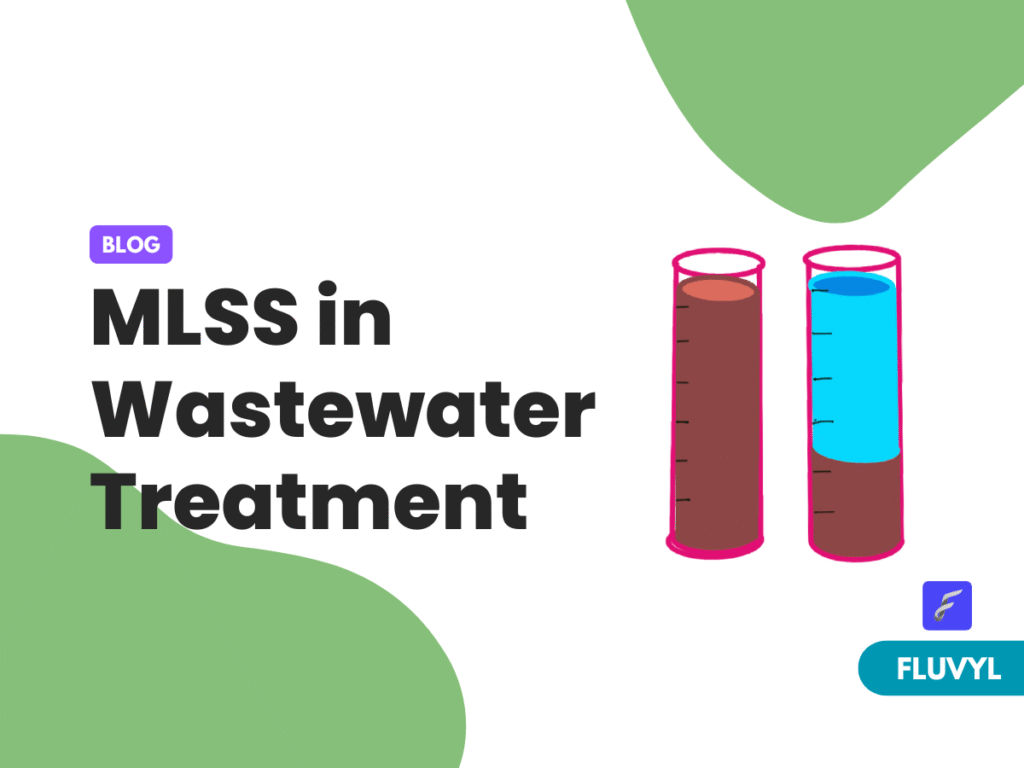
Synopsis
- MLSS stands for Mixed Liquor Suspended Solids and is key to biological wastewater treatment.
- The ideal MLSS concentration depends on process type, with MBR systems requiring the highest levels.
- MLSS affects several operational parameters including F/M ratio, oxygen demand, and sludge settling.
- Measurement of MLSS is done via gravimetric methods or modern online sensors.
- Proper control of MLSS ensures efficient BOD/COD removal, stable sludge age, and regulatory compliance.
MLSS in wastewater treatment is one of the most critical parameters used to assess and control the efficiency of biological treatment systems, especially in activated sludge processes. MLSS stands for Mixed Liquor Suspended Solids, which refers to the total concentration of suspended solids—including active microorganisms and inert particles—in the aeration tank of a wastewater treatment plant.
Understanding the role of MLSS in wastewater treatment is essential for plant operators, environmental engineers, and process designers to maintain optimal performance and meet effluent quality standards.
In this comprehensive blog, we will explore the fundamentals, importance, monitoring, and optimization of MLSS in wastewater treatment, along with operational challenges, design considerations, and practical tips for maintaining the right MLSS concentration.
What is MLSS in Wastewater Treatment?
MLSS refers to the concentration of suspended solids in the mixed liquor of an aeration tank during the activated sludge process. These solids primarily consist of microorganisms and inert suspended matter that help in breaking down organic pollutants.
In simple terms, when wastewater enters the biological reactor (usually an aeration tank), it is mixed with return activated sludge (RAS) and aerated. This mixture is known as mixed liquor, and the total suspended solids in it are termed as Mixed Liquor Suspended Solids (MLSS). MLSS range in aeration tank refers to the optimal concentration of suspended solids required for effective biological treatment in the activated sludge process. Maintaining the correct MLSS range in aeration tank is crucial, as it ensures there are enough microorganisms to break down organic pollutants efficiently.
Typically, the ideal MLSS range in aeration tank falls between 2,000 to 4,000 mg/L, depending on the plant design and influent characteristics. If the MLSS range in aeration tank is too low, treatment efficiency drops; if it’s too high, oxygen transfer becomes less effective, and sludge settling issues may occur. Therefore, monitoring and controlling the MLSS range in aeration tank is essential for stable and efficient wastewater treatment operations.
Key Components of MLSS:
- Active biomass (microorganisms)
- Inert suspended solids
- Dead microbial cells
- Organic and inorganic matter
Why MLSS is Important in Wastewater Treatment
The MLSS in wastewater treatment is a crucial performance indicator. It tells us how many active microorganisms are available to digest and degrade organic pollutants.
If the MLSS level is too low:
- There won’t be enough microorganisms to treat the incoming load.
- Effluent quality may suffer.
If the MLSS level is too high:
- Oxygen demand increases.
- Settling in the secondary clarifier becomes poor.
- Sludge bulking or foaming can occur.
Maintaining the correct range of MLSS ensures:
- Optimal biological activity
- Efficient BOD and COD removal
- Stable sludge settling
- Controlled sludge production
Typical MLSS Ranges in Different Wastewater Systems
The following table presents typical MLSS ranges for various treatment processes:
| Treatment Process | Typical MLSS Range (mg/L) |
|---|---|
| Conventional Activated Sludge (CAS) | 2000 – 3500 |
| Extended Aeration | 3000 – 6000 |
| Sequencing Batch Reactor (SBR) | 3000 – 5000 |
| Membrane Bioreactor (MBR) | 8000 – 12000 |
| Oxidation Ditch | 2500 – 4500 |
It’s important to note that the optimal MLSS level varies depending on:
- Influent strength
- Design parameters
- Process type
- Sludge retention time (SRT)
MLSS vs MLVSS: Understanding the Difference
Often, people confuse MLSS with MLVSS. Let’s clarify:
- MLSS (Mixed Liquor Suspended Solids): Total suspended solids in the aeration tank, including active biomass and inert solids.
- MLVSS (Mixed Liquor Volatile Suspended Solids): Organic portion of MLSS, representing the actual microbial mass.
Generally, MLVSS makes up 60-80% of MLSS. Therefore, MLVSS is more representative of the active portion that drives biological treatment, but MLSS is easier to measure and commonly used for operational control.
How to Measure MLSS in Wastewater Treatment
The standard method to measure MLSS in wastewater treatment involves:
- Collecting a representative sample of the mixed liquor from the aeration tank.
- Filtering the sample using a glass fiber filter or standard filter paper.
- Drying the filter with the retained solids at 103-105°C.
- Weighing the residue to determine solids content in mg/L.
This procedure is described in detail in Standard Methods for the Examination of Water and Wastewater (SM 2540D).
Regular MLSS monitoring helps plant operators:
- Track system performance
- Adjust wasting and RAS rates
- Maintain optimal food-to-microorganism (F/M) ratios
The Role of MLSS in Activated Sludge Process
The activated sludge process is heavily dependent on the right MLSS concentration for:
- Degrading BOD, COD, and ammonia
- Ensuring complete nitrification and denitrification
- Maintaining sludge age and microbial balance
Key Process Parameters Affected by MLSS:
- Sludge Retention Time (SRT): Longer SRT usually means higher MLSS.
- Oxygen Demand: Higher MLSS increases oxygen consumption.
- Settling Characteristics: High MLSS can hinder sludge settling and increase effluent TSS.
Operators must carefully balance MLSS to achieve the desired treatment goals.
Understanding MLSS in Wastewater Treatment: Key Points Explained
1. What is MLSS?
MLSS stands for Mixed Liquor Suspended Solids. It is a critical parameter in the biological treatment process of wastewater. MLSS represents the concentration of suspended solids — including microorganisms and organic matter — present in the aeration tank of a wastewater treatment plant.
2. What is MLSS in STP (Sewage Treatment Plant)?
In an STP, MLSS helps monitor the biomass responsible for breaking down pollutants. Maintaining the right MLSS in STP ensures optimal performance of the activated sludge process and prevents system imbalances.
3. MLSS in Wastewater: Why It Matters
MLSS in wastewater provides insights into the microbial activity, system health, and sludge load. It serves as a control parameter for aeration, sludge wasting, and overall plant efficiency.
4. MLSS in ETP (Effluent Treatment Plant)
Just like in STPs, MLSS in ETP is monitored to evaluate biological treatment efficiency, especially when treating industrial wastewater with complex organic loads.
5. MLSS Wastewater Meaning
In simple terms, MLSS wastewater meaning refers to the solid content in the aeration tank where biological treatment happens. It includes living and non-living solids suspended in the mixed liquor.
6. MLSS Range in Aeration Tank
Maintaining the MLSS range in aeration tank is crucial. Typical values:
- Municipal wastewater: 2,000 – 4,000 mg/L
- Industrial wastewater: 3,000 – 5,000 mg/L (may vary based on loading)
Higher or lower MLSS values can lead to poor treatment or excessive energy usage.
7. MLSS vs TSS: What’s the Difference?
- MLSS: Refers to suspended solids in the aeration tank (mixed liquor).
- TSS: Total Suspended Solids in any part of the wastewater (influent, effluent, etc.).
MLSS vs TSS is often confused, but TSS includes all suspended solids while MLSS is specific to the biological reactor.
8. MLSS and MLVSS Difference
- MLVSS (Mixed Liquor Volatile Suspended Solids) is the organic portion of MLSS and indicates microbial biomass.
- MLSS = MLVSS + non-biodegradable solids.
Understanding the MLSS and MLVSS difference helps determine the active biomass in the treatment system.
9. How to Calculate MLSS in Wastewater?
To determine how to calculate MLSS in wastewater, follow this simple MLSS procedure:
MLSS (mg/L) = (Weight of residue after filtering and drying ÷ Volume of sample) × 1000
You take a known volume of mixed liquor, filter it, dry the filter at 103–105°C, and weigh the residue.
10. MLSS in Sewage Treatment Plant Monitoring
Daily monitoring of MLSS in sewage treatment plant is essential to control sludge age, oxygen supply, and overall treatment performance. Sudden dips or spikes indicate system upset or operational issues.
11. MLSS Wastewater Control Tips
- Too low MLSS → Poor BOD/COD removal, washout risk
- Too high MLSS → High oxygen demand, settling issues in secondary clarifier
- Maintain target wastewater MLSS based on loading and plant design.
Controlling and Optimizing MLSS in Wastewater Treatment
Maintaining the ideal MLSS range requires routine monitoring and control of the following factors:
- Sludge Wasting Rate (WAS): Adjusting the amount of sludge wasted from the system helps control MLSS levels.
- Return Sludge Flow (RAS): Affects how much sludge is recycled back to the aeration tank.
- Aeration Efficiency: Sufficient aeration ensures microbial activity and prevents anaerobic conditions.
- Influent Load: Changes in flow or strength of influent can influence required MLSS levels.
- Temperature: Biological activity slows down in colder climates; MLSS adjustments may be needed.
Automation and online sensors are increasingly used to control MLSS and optimize energy use in modern plants.
MLSS and F/M Ratio
The Food to Microorganism (F/M) ratio is another critical parameter in biological treatment. It is defined as:

Although MLVSS is used in calculations, the MLSS is often used as a surrogate because it’s easier to measure.
A balanced F/M ratio ensures:
- Effective substrate utilization
- Avoidance of sludge bulking
- Stable microbial community
MLSS is central to maintaining a proper F/M balance in wastewater treatment.
Troubleshooting MLSS-Related Issues
Sometimes, plants face operational challenges due to improper MLSS in wastewater treatment. Common problems include:
1. Low MLSS
- Cause: Over-wasting, low influent load, high flow dilution
- Effect: Poor BOD removal, low sludge age
- Solution: Reduce wasting, recycle more sludge
2. High MLSS
- Cause: Under-wasting, high influent load
- Effect: Settling issues, high oxygen demand
- Solution: Increase wasting, monitor clarifier performance
3. Foaming or Bulking Sludge
- Cause: Filamentous bacteria thrive in high MLSS or low F/M
- Solution: Monitor DO levels, implement selectors, optimize wasting
Common Misconceptions About MLSS
- Higher MLSS always means better treatment – Not true. Overloaded systems suffer from poor settling and higher energy use.
- MLSS and MLVSS are the same – MLVSS represents active biomass; MLSS includes inert solids too.
- MLSS can be neglected in design – MLSS is central to determining reactor volume, aeration needs, and SRT.
Conclusion
MLSS in wastewater treatment is a foundational parameter that governs the efficiency of biological processes. From influencing the microbial population to impacting energy requirements and effluent quality, MLSS must be carefully managed.
Whether you operate a municipal sewage treatment plant or an industrial ETP, understanding and optimizing MLSS in wastewater treatment is essential for regulatory compliance and sustainable operation.

